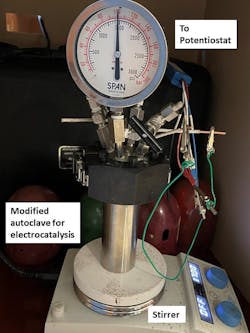Researchers at the University of Illinois Chicago (UIC) have taken the century-old lithium-mediated ammonia synthesis (LiMAS) process and dramatically improved its efficiency and selectivity.
This low-temperature, cyclic process combines nitrogen gas and a hydrogen-donating fluid, such as an alcohol, with a charged lithium electrode. Nitrogen atoms stick to the lithium before combining with hydrogen to make ammonia. LiMAS also is regenerative, restoring the original materials with each cycle of ammonia production (Figure 1).
According to UIC Associate Professor of Chemical Engineering Meenesh Singh, the key to this improvement was better understanding how the reaction works and then being able to speed it up. This included optimizing both the hydrogen donor and counter ion used in the lithium salt while also increasing nitrogen pressure in the reaction.
Singh believes the current process if scaled up, would produce ammonia at $450/ton, which he says is 60% cheaper than prior lithium-based approaches and other proposed green methods.
Singh and his fellow researchers are now partnering with General Ammonia Co. to pilot and scale up the process at a plant in the Chicago area. The company has a stated target price for ammonia below $220/ton.
First up is to design a laboratory scale 1kg/day electrolyzer and then an electrolyzer stack. This will be roughly the size of a shipping container, including supporting components such as a compressor, rectifier and air separation equipment.
“Scaling a chemical process from this to industrial scale, i.e. 1–100 tons/day, requires careful planning and execution,” he noted.
Key steps include thoroughly understanding the process at the laboratory scale, which will be done at UIC, conducting pilot-scale operations to validate (1 kg/day) scalability, optimizing process parameters, selecting and designing appropriate equipment and conducting environmental impact assessments.
“Funding is necessary to execute scale-up tasks. For example, we will be doing front-end loading (FEL) for conceptual process design first,” he added.
Singh shared that the U.S. Department of Energy typically wants target selectivities of over 70% and energy efficiency over 60% for industrial-scale production of ammonia. While his and other groups have hit the 70% selectivity mark, the higher voltage requirements of LiMAS lowers its energy efficiency.
“We are developing alternatives that will allow us to reduce the voltage to get to an energy consumption of ~9.4 kWh/kg of NH3, which is comparable to state-of-the-art ammonia synthesis approaches,” he explained, adding that achieving these aggressive targets requires support from the government, state holders and venture capitalists.
About the Author
Seán Ottewell
Editor-at-Large
Seán Crevan Ottewell is Chemical Processing's Editor-at-Large. Seán earned his bachelor's of science degree in biochemistry at the University of Warwick and his master's in radiation biochemistry at the University of London. He served as Science Officer with the UK Department of Environment’s Chernobyl Monitoring Unit’s Food Science Radiation Unit, London. His editorial background includes assistant editor, news editor and then editor of The Chemical Engineer, the Institution of Chemical Engineers’ twice monthly technical journal. Prior to joining Chemical Processing in 2012 he was editor of European Chemical Engineer, European Process Engineer, International Power Engineer, and European Laboratory Scientist, with Setform Limited, London.
He is based in East Mayo, Republic of Ireland, where he and his wife Suzi (a maths, biology and chemistry teacher) host guests from all over the world at their holiday cottage in East Mayo.


